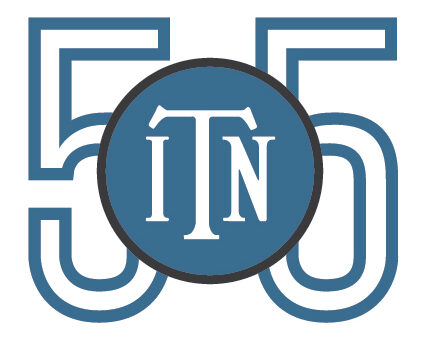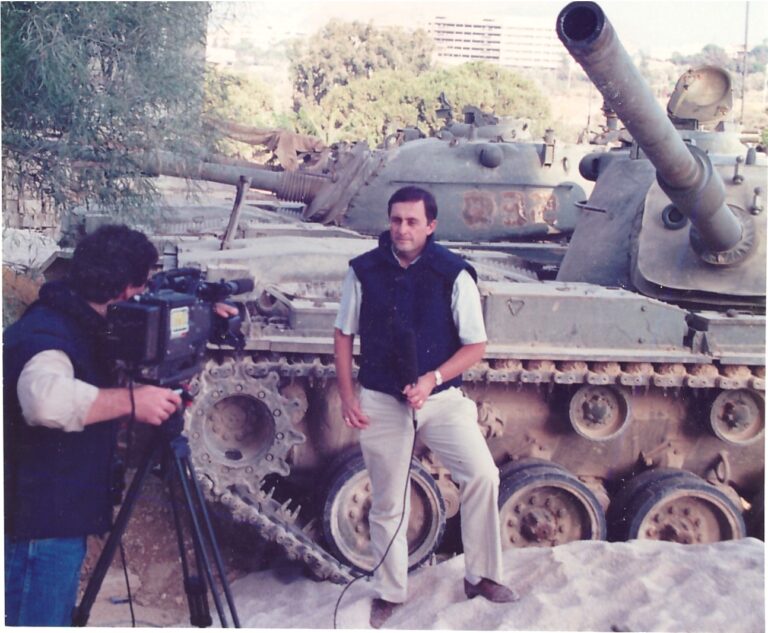Robert Moore was ITN’s Middle East Correspondent in the 1990s. He’s written this article for the ITN 1955 Club Newsletter about how ITN today, when reporting on the current Israel/Hamas conflict, can draw on a long legacy of remarkable Middle East frontline reporting.
The brutality unfolding in the Middle East has been an extraordinary test of ITN’s resources and resilience – for reporters, camera operators, newsdesks and management. Harrowing images are flooding across our screens. At the same time, Israelis and Palestinians are questioning broadcasters’ objectivity. The use of language in how we describe the conflict, and the power of images in shaping the debate, is again centre stage.
Our coverage of the Gaza tragedy in this round of fighting, however, can draw on editorial strengths that have anchored five decades of ITN reporting from the Middle East.
A war that ignites such fierce controversies and emotions highlights the value of considered, thoughtful, bulletin-style news programming. This remains ITN’s calling-card: switch on News at Ten or Channel Four News at the end of the day and you get vivid on-the-ground reporting blended with analysis, not the partisan noise and guesswork ricocheting across social media postings.
Heritage
Another reason that ITN can cover today’s Israeli-Palestinian crisis with confidence may not be well understood by a new generation of our journalists. In a word: heritage.
ITN has had a long history of remarkable scoops and frontline reporting in the Middle East, and for decades we have cultivated a network of fixers, drivers, and local camera operators who have taken great risks to deliver dramatic – and often heart-breaking – images to ITN audiences.
In 1970, ITN filmed some of the most remarkable images ever recorded of Palestinian militants. Three planes had been hijacked and forced to land at Dawson’s Field, a remote Jordanian desert airstrip.
Reporter Michael Nicholson and Palestinian cameraman Ghassan Dallal had already sent reports to London, and they thought their assignment was finished.
But after an unexpected tip-off, they returned to the scene. Ghassan started filming again. He was rolling when the three planes were blown up by the hijackers. Once the footage reached ITN, it provided – as recalled by newscaster Andrew Gardner – some of the most dramatic images ever to feature on News at Ten.
Yom Kippur War
Three years later, ITN burnished its reputation covering the 1973 Yom Kippur War. Reporters Gerald Seymour and Michael Nicholson were at the heart of it. It was also the conflict in which our engineers and crews excelled. For the first time, TV war reporting was reaching living rooms in Britain on the same day as battles raged across the Middle East.
Thanks to satellites deployed in the field for the first time, and the ingenuity of our technical teams, television was finally beating Fleet Street in bringing dramatic war reporting to a British audience.
More than a decade later, in 1985, Brent Sadler and his superbly resourceful Lebanese fixer Mehdi Medhi were the only news team in the world to break the siege of Bourj el Barajneh to reveal the horrors inside the camp. They did so by running across no-man’s-land in the dead of night, trusting the word of a Palestinian fixer inside.
Three years earlier, they were similarly at the scene in the aftermath of the Sabra and Shatila refugee camp massacre in Beirut, perpetrated by an Israeli-backed Christian militia. In both cases, this was courageous reporting with a powerful message that resonates today for Gaza: civilians are the ones who suffer as both sides wage their age-old vendettas.
I spent years in the 1990s reporting from Israel and Gaza, and my strongest memory is the work of our local teams and Palestinian fixers. They were heroic journalists in their own right.
West Bank
One day on the West Bank, alongside cameraman Alan Thompson, I was pinned down by withering fire from an Israeli helicopter gunship. The ground was exploding all around us. We escaped with our lives thanks to a fixer and a driver who spirited us out of the mayhem. They had a simple message as we raced back to Jerusalem: “Tell our story.”
That’s a message that remains true for our teams today. It is the thread that links ITN’s reporting from Dawson’s Field, to the Yom Kippur War, to Lebanon’s civil war, to today’s Gaza crisis.
Tell the story. Bear witness. Place the plight of the innocents at the heart of the reporting.
That’s what we have always done best

